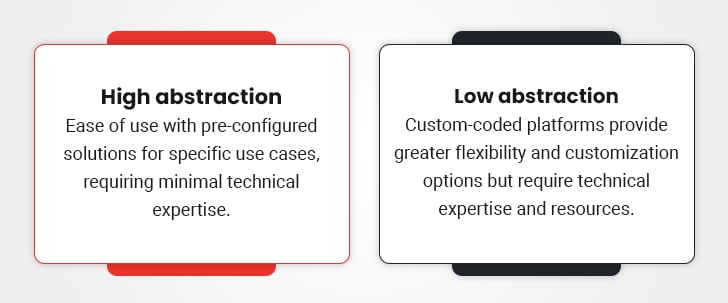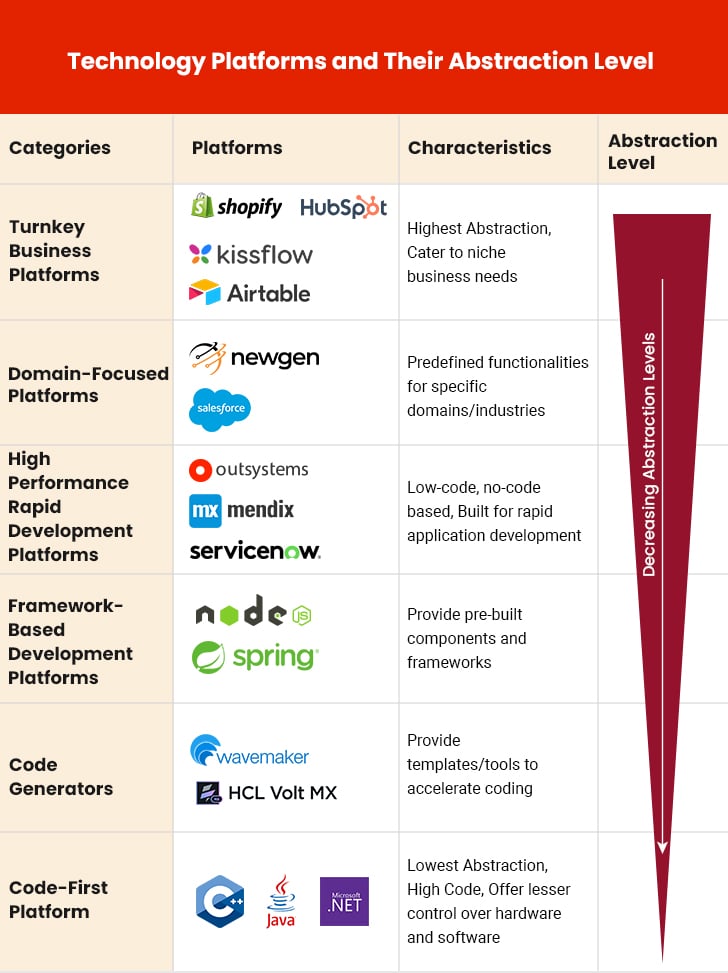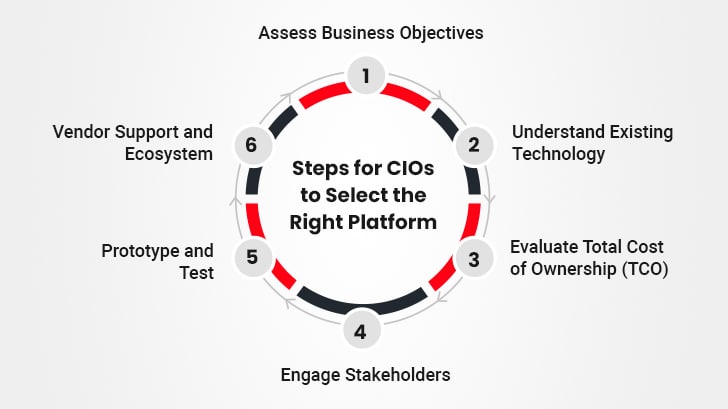The right technology platform can make or break an organization’s ability to scale and innovate. For a Chief Information Officer (CIO), selecting the right platform is not merely a technical decision but a strategic one. One critical factor that often goes unnoticed in this decision-making process is the abstraction level of technology platforms. It’s important to understand how technology platforms are structured—how much control you need versus how much ease you seek. Understanding this can help you align technology with business goals, ensure scalability, and drive digital transformation.
When evaluating platforms, businesses must ask themselves key questions:
- What level of customization do we require?
- How much flexibility do we need to accommodate future changes?
- Are we looking for a solution that offers quick deployment with minimal IT Dependency, or do we need a platform that allows deep integration and full control?
- Are we prioritizing the process of “How to Develop” or the outcomes of “What to Develop”?
Understanding these factors is essential to making a strategic choice that aligns with both immediate and long-term business objectives.
Successful companies have leveraged these evaluations to choose platforms that empower them to innovate swiftly without sacrificing flexibility. For instance, a company focused on rapid market adaptation might prioritize a high-abstraction platform to reduce development cycles.
In this blog, we’ll explore how abstraction levels in technology platforms influence scalability, functionality, and innovation. We’ll discuss how finding the right fit can empower your organization to grow dynamically while maintaining the flexibility needed to adapt to future challenges.
What is “Abstraction Level” in Technology Platforms?
The abstraction level of a technology platform refers to the degree of complexity hidden from the end-user or developer. It defines how much of the underlying technical intricacies are abstracted away to simplify usage. Platforms can be categorized in a hierarchy that spans from low abstraction (high-code) to high abstraction (no-code), each serving specific business needs and capabilities:

Now, let’s explore the different categories of technology platforms based on their abstraction levels. Each category serves unique business needs, balancing ease of use, flexibility, and customization.
Categorizing Technology Platforms Based on Their Abstraction Levels
Turnkey Business Platforms (Highest Abstraction)
- Highly specialized platforms catering to niche business needs.
- Focused on delivering out-of-the-box functionality for targeted business use cases.
- Examples: Shopify for ecommerce, HubSpot for CRM, Kissflow for workflow automation, Airtable for database management.
Domain-Focused Platforms
- Offer predefined functionalities tailored to specific domains or industries.
- Designed to streamline business processes with minimal customization efforts.
- Examples: Newgen, Salesforce.
High Performance Rapid Development Platforms (Low-Code/No-Code)
- Abstract most technical details, offering visual development environments.
- Designed for rapid application development, empowering non-technical users to build solutions with minimal IT dependency.
- Examples: OutSystems, Mendix, ServiceNow
Framework-Based Development Platforms
- Provide pre-built components and frameworks, balancing control and ease of use.
- Suitable for enterprise-grade solutions that require moderate customization and scalability.
- Examples: Node.js, Spring Boot.
Code Generators
- Provide templates or tools to accelerate coding without sacrificing control.
- Ideal for teams that need a mix of efficiency and control over the application logic.
- Examples: WaveMaker, HCL Volt MX.
Code-First Platform (High-Code)
- Offer granular control over hardware and software.
- Best suited for high-performance systems requiring significant customization and flexibility for deep integration.
- Examples: C++, Java, and .NET frameworks.

Why Does Abstraction Level Matter?
1. Business Agility
- High-level platforms enable faster go-to-market strategies, crucial in competitive markets.
- Low-level platforms offer the flexibility to adapt to unique, long-term business needs.
2. Cost Implications
- Higher abstraction reduces development time and costs but may limit flexibility.
- Lower abstraction provides control but requires skilled resources and longer timelines.
3. Scalability and Integration
- Platforms with lower abstraction allow seamless integration with complex systems.
- High-abstraction platforms may excel in scaling quickly but could face integration challenges.
4. Skillset Availability
- High-abstraction platforms lower the barrier for entry, enabling a broader talent pool.
- Low-abstraction platforms demand specialized expertise.
Finding Your Perfect Fit: ShapeSteps for CIOs to Select the Right Platform

1. Assess Business Objectives
- Define Key Performance Indicators (KPIs): Start by identifying KPIs such as time-to-market, operational efficiency, and customer satisfaction to guide platform selection.
- Immediate vs. Long-Term Needs: Determine whether your focus is on rapid deployment for immediate goals or creating a highly customizable solution for future scalability.
- Example Insight: A retail company aiming for quicker ecommerce setup might prioritize high-abstraction platforms like Shopify.
2. Understand Existing Technology Ecosystem
- Compatibility Metrics: Evaluate how well the platform integrates with existing tools, such as ERPs, CRMs, or cloud infrastructure.
- Infrastructure Audit: Conduct an audit to ensure the new platform can leverage existing investments effectively.
- Example Insight: A manufacturing company using SAP should consider platforms offering seamless SAP integration.
3. Evaluate Total Cost of Ownership (TCO)
- Break Down Costs: Factor in licensing, development, maintenance, and potential upskilling costs.
- Measure ROI: Use ROI-driven metrics such as reduction in operational costs or increase in productivity to justify platform investment.
- Example Insight: A mid-sized firm might opt for a low-code platform to minimize upfront costs while achieving significant savings on development timelines.
4. Engage Stakeholders
- Collaboration Framework: Create a framework for gathering input from business leaders, IT teams, and end users.
- User Acceptance Testing (UAT): Involve stakeholders early to ensure the platform meets practical requirements.
- Example Insight: Engaging marketing teams for CRM platform selection to ensure platform alignment with lead management workflows.
5. Prototype and Test
- Proof-of-Concept Metrics: Develop prototypes to measure usability, performance, and alignment with business goals.
- Iterative Feedback: Use iterative cycles to refine platform implementation based on test results.
- Example Insight: A financial institution testing a low-code platform can use KPIs like time-to-deliver a new feature to validate the choice.
6. Vendor Support and Ecosystem
- Evaluate Ecosystem Strength: Look for platforms with active communities, robust documentation, and reliable vendor support.
- Vendor Longevity Metrics: Assess the vendor’s track record and long-term viability to avoid future disruptions.
- Example Insight: A healthcare organization might prioritize platforms with strong compliance support for HIPAA or GDPR standards.
Case in Point
Strategic Evaluation: Choosing the Right Claims Platform for an Insurer
Challenge: Facing delays and integration challenges with its outdated claims system, a mid-sized insurance company adopted a structured approach to evaluate technology platforms.
Objective: The aim was to reduce claims processing time by 50%; enable real-time tracking for customers and internal teams; and simplify integrations with third-party systems, including core policy platforms and AI-based fraud detection tools.
Solution & Benefits: The CIO assessed Code-First, Framework-Based, and Turnkey Platform options, considering factors like scalability, speed, and ease of integration. A pilot of the Low-Code platform demonstrated its effectiveness, achieving a 40% reduction in processing time during testing. This methodical evaluation led to the adoption of a scalable solution that reduced claims processing time by 60%, improved customer satisfaction by 35%, and saved $500,000 annually.
Key Takeaways
While high-abstraction platforms provide ease of use and quick deployment, they may fall short in terms of customization and long-term adaptability. On the other hand, low-abstraction platforms and custom-coded solutions offer unparalleled flexibility but at a higher cost and complexity. Businesses need to assess their growth trajectory and determine the best fit for their specific business use case.
- The abstraction level of a platform is a pivotal factor in ensuring technology aligns with business goals.
- CIOs must balance speed, flexibility, cost, and scalability in their decisions.
- Engaging stakeholders and leveraging prototypes can mitigate multiple risks in platform selection.
By understanding and aligning the abstraction level of technology platforms with organizational needs, CIOs can ensure that their technology investments deliver optimal value, fostering innovation and growth.





